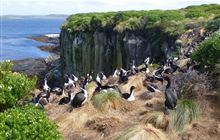Winter life of Auckland Island pests revealed
Archived content: This media release was accurate on the date of publication.
Introduction
Return of the winter field team from Auckland Island brings new insights into the work needed to make the subantarctic island pest-free.Date: 04 October 2019
The Department of Conservation (DOC) is working with Ngāi Tahu to restore the mauri and natural ecosystems of Auckland Island by removing pigs, mice and feral cats.
A 19-person team, which returned to Invercargill last week, braved cold, wet and windy conditions to learn more about the behavior of the introduced pests, which have decimated the island’s unique native plants and animals over the past 200 years.
Successful testing of potential cat baits and learning how the pest animals behave in winter were key features of the trip, says DOC Maukahuka Pest Free Auckland Island project manager Steve Horn.
“Methods for removing feral cats from islands are not well developed so it was pleasing to see three out of four meat baits tested proved appealing to cats.”
“Our monitoring found mouse numbers had exploded after tussock seeding last summer, which appears to have also caused an increase in young cats.”
“Disturbingly we also saw a cat eating a young albatross, which it may have killed. We know that cats have devastated sea bird populations on the island, but this is the first time we’ve seen and photographed a white-capped mollymawk being eaten.”
Most (95%) white-capped mollymawk breed on nearby tiny pest-free Disappointment Island. Only a small number attempt to breed on Auckland Island on cliff terraces where pigs can’t reach them.
Ngāi Tahu kaumatua Stewart Bull, who joined the winter pickup trip, says restoring the island enables Ngāi Tahu to fulfill its kaitiakitanga responsibilities.
“It was an eye-opener to visit the island and see how harsh it is and how depleted of wildlife. The opportunity for Ngāi Tahu to work alongside DOC to turn this around and to reconnect to this place, is really exciting.”
The field team put GPS collars on 11 cats, adding to the 20 animals already being tracked from last summer. This work has revealed cats ranging up to 70 square km in search of food and moving to steep coastal areas when seabirds have young.
Two new shelters were installed at Deas Head and Camp Cove, to support further field work in those areas. An archaeologist assessed a proposed operational base site near the historic Hardwicke settlement, which was occupied by British settlers from 1849 for several years.
The winter field team included DOC staff, two Ngāi Tahu representatives, an archaeologist and engineer from Boffa Miskell. The Winton Rotary Club also supported the trip by providing flat pack toilet buildings for assembly.
Removing pests from Auckland Island, New Zealand’s fifth-largest island, is a long-term project and currently in its feasibility and planning stages. A report on the feasibility of the ambitious project is due to be considered by DOC’s Island Eradication Advisory Group in coming weeks.
Achieving this goal would set more than 400 native plants, insects and birds on the path to recovery and see New Zealand’s subantarctic island region and World Heritage Area free of introduced pest animals. This would be a significant step towards Predator Free 2050.
Contact
For media enquiries contact:
Email: media@doc.govt.nz

